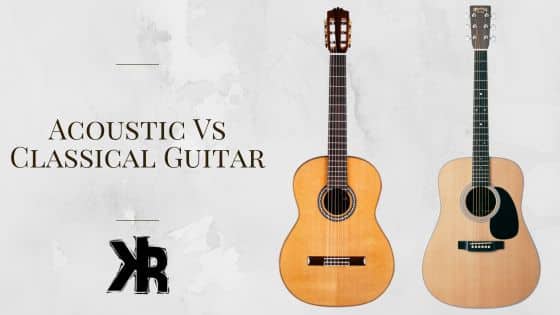Table of Contents
Are you thinking of learning to play the guitar for the first time, or looking to add to your musical repertoire? Then you might have found a debate between acoustic vs classical guitar. Chances are, you’re confused as to which might fit you best.
Now, how in the world do you choose one as the right fit for you?
In this Killer Rig article, I will explore the nuances that set these two instruments apart. Exploring their histories, construction, sound, and playing techniques.
By the end, you’ll be well-equipped to make an informed decision that suits your tastes, goals, and preferences. So join me as I compare these two members of the guitar family.
Acoustic Vs Classical Guitar Summary
| Classical Guitar | Acoustic Guitar |
|---|---|
| Nylon strings | Steel strings |
| Softer on fingers | Tougher on fingers |
| Mellow, soft sound | Bright, bold sound |
| Ideal for classical, Latin, and some pop music | Versatile, can play rock, blues, country, jazz, etc. |
| Typically has a wider neck | Typically has a narrower neck |
| Smaller body size | Larger body size |
| Does not come with a truss rod | Comes with a truss rod for neck adjustment |
| Often used for fingerpicking | Can be used for both strumming and fingerpicking |
| Less volume and power | More volume and power |
| Usually cheaper | Can be more expensive |
Understanding Classical Guitars
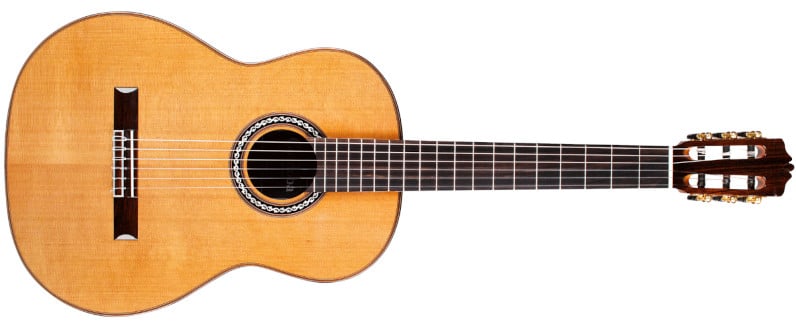
Let’s explore classical guitars and understand what sets them apart in the string instrument family. The key difference lies in the strings.
Classical guitars use nylon strings, which produce a softer and warmer sound compared to steel. This is similar to the difference between silk and steel in terms of texture and strength.
The uniqueness of classical guitars isn’t just in the strings. They also feature a wider neck compared to other guitars. This wider neck allows for more finger room, affecting the playing experience and making it different from other guitar types.
These guitars are named for their association with classical music, but they are not limited to this genre. They are versatile and can be used across various musical styles.
Recognizing Acoustic Guitars
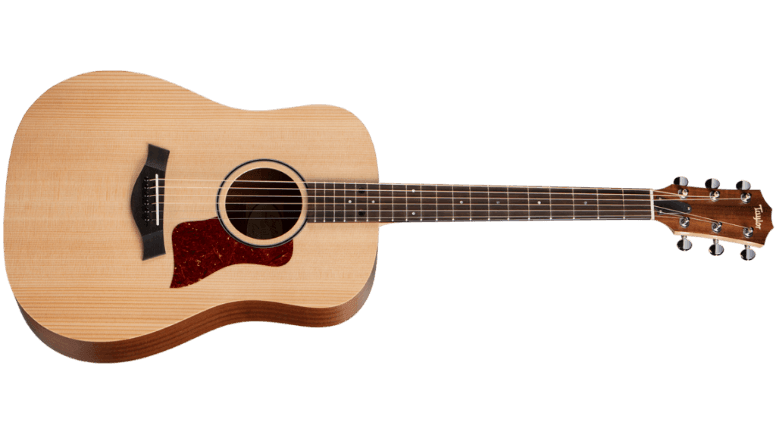
What is an acoustic guitar? It’s a guitar that produces sound acoustically, using a soundboard to turn the vibrations from the strings into sound waves, without any electronic amplification. This process involves wood, metal, and the air, to create music.
When strings are plucked or strummed, they vibrate. These vibrations go through the bridge to the top of the guitar, known as the soundboard, which then vibrates and emits sound through the soundhole.
Acoustic guitars usually have six steel strings, providing a clear and resonant sound. The strings are numbered from one to six, with the first being the thinnest and highest-pitched, and the sixth the thickest and lowest-pitched.
Acoustic guitars vary in shapes and sizes, each producing its own sound. The dreadnought, with a larger body, is known for a powerful sound. Other types, like the concert and grand-concert guitars, offer a balanced tone.
Key Differences
Now, let’s unpack the world of classical and acoustic guitars. Don’t they look alike? Yes, they do. But their similarities? Well, they end there. Here’s why.
Strings
Strings! A significant aspect that sets these two types apart. Classical guitars use nylon strings, soft to touch, kind to your fingers.
Acoustic guitars? Well, they use steel strings. More demanding, admittedly, but the payoff is a vibrant, robust sound that reverberates in your ears.
The choice of string material greatly impacts the playing experience. But also the musical genres and techniques associated with each type.
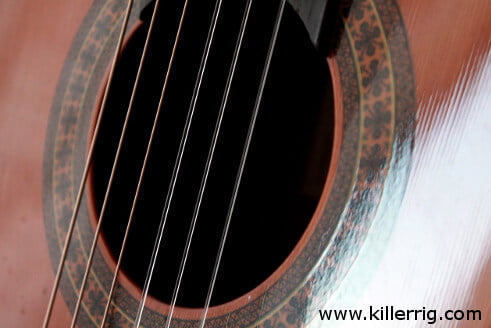
Bodies
Moving onto their bodies, which is also a critical difference. If you prefer a lighter load, something small, manageable, especially if you’re just starting or perhaps younger in age, a classical guitar might be your best bet.
But if you’re looking for a louder, resonating sound, then the slightly more substantial, more robust acoustic guitar should be your choice.
Acoustic guitars also come in various body shapes and sizes. From the compact parlor, to the larger dreadnought and jumbo models. These differences in size and shape can affect the instrument’s volume, resonance, and tonal balance.
Woods
Both acoustic and classical guitars use a variety of tonewoods for their construction. With each wood type imparting its own sonic characteristics. Common woods for acoustic guitars include spruce, mahogany, and rosewood.
While classical guitars often feature cedar, cypress, and rosewood. The choice of wood affects the resonance, sustain, and tonal qualities. This makes it an essential aspect of the instrument’s overall sound.
Necks
Now, the necks. The necks of classical guitars are wider. Sure, for those with petite hands, it could be a challenge. But on the upside, there is more room for your fingers to move around. Plus, they aren’t real thick.
Acoustics, with their slimmer necks, provide an easier grip for some, making the playing experience quite different. But you will find they are a bit thicker than the classical necks, as their radius is much different.
You will also find that most classical guitar necks don’t have any fret markers. The fret markers can be very helpful for beginners, and so this is something you should watch for when considering a classical.
Bridge
The bridges on these guitars are also quite a bit different. With a regular acoustic, the strings have ball ends. This allows you to feed them through a hole in the bridge and have them seat and set themselves.
But with a classical guitar, the strings must be wrapped around their bridge and tied. There are no ball ends and so the process is a bit more complex.
Playing Techniques and Styles
The acoustic is well-suited for a wide variety of musical genres such as folk, rock, country, bluegrass, and singer-songwriter styles.
Acoustic guitar players often employ techniques like flatpicking. It involves using a pick to strum or pluck the strings, producing a bright, percussive sound.
The classical is primarily associated with fingerstyle playing. This is where the nylon strings are plucked with the fingernails or fingertips. This technique provides a wide range of expression and dynamics.
But also the ability to play multiple voices simultaneously. Classical guitarists often use rest-stroke and free-stroke plucking techniques to achieve different tonal colors and articulations.
Sound
Finally, let’s address the heart of the matter, the sound. Classical guitars sing a soft, warm and soothing melody, a beautiful companion to classical music. However, they aren’t one-trick ponies. Folk, Latin music? They handle those beautifully too.
Acoustic guitars, on the flip side, come with their steel strings echoing louder, brighter tones. Perfectly suited to everything from rock to country, even pop.
Do They Have Similarities?
Next, let’s explore the mutual traits of classical and acoustic guitars.
Tuning
Now, we’ll kick things off with tuning. You see, no matter if you’re strumming a classical or an acoustic guitar, the tuning process remains identical.
From the thickest to the leanest, the strings tune up to E, A, D, G, B, and E. This uniform tuning is a shared attribute bridging these guitar types together.
Number of Strings
Shifting gears, let’s chitchat about the number of strings. Both classical and acoustic guitars sport six strings. It might seem like an insignificant detail, but it’s pretty critical.
It’s the six-string ensemble that offers both types of guitars their broad-ranging notes and versatility.
Fretboards
Next in line, we’re going to explore the fretboard.
It’s the stage where you apply pressure on the strings to produce varying notes. Whether it’s a classical or an acoustic guitar, they both have fretboards that function similarly.
Apply pressure on a string at a designated fret, and you generate a specific note.
Guitar Chords
Last, we come to chord configurations. If you’ve ever laid eyes on guitar sheet music, you’re aware that chords are symbolized by diagrams.
These illustrations guide you on where to place your fingers on the fretboard to perform a specific chord.
The chord configurations hold true for both classical and acoustic guitars. So, once you master a chord on one, you’ve simultaneously aced it on the other.
And with the ability to use the same learning materials, even online lessons will be similar.

Which Guitar is Right for You?
So maybe it’s time to choose the guitar that’s right for you. At least now that you are more informed you can choose between acoustic and classical guitars. Consider your preferences, musical objectives, and comfort levels when making this choice.
Musical Ambitions
Consider the types of music that you enjoy the most. Whether it’s rock ‘n’ roll, country, pop, bluegrass, or singer-songwriter music, an acoustic guitar could be a great match for you.
If you enjoy the rhythm of a guitar and imagine playing with a pick to set the beat, an acoustic guitar may be the right choice for you.
However, if you’re drawn to flamenco, bossa nova, or Latin music, a classical guitar might be more suitable.
It’s also important to think about the playing techniques and styles that interest you. For those who are interested in fingerstyle playing and want to learn complex, multi-note techniques, a classical guitar is a really good option.
Comfort and Playability
Before making a decision, it’s essential to try out both kinds of guitars. At least to determine which one feels more comfortable in your hands.
Pay attention to the neck width, fretboard shape, and string tension, as these factors can greatly affect your playing experience.
For those with smaller hands or limited finger strength, an acoustic guitar’s narrower neck and thinner fretboard might be more comfortable. However, keep in mind that the steel strings can be tougher on the fingertips.
Conversely, the classical guitar’s wider neck and flatter fretboard may be challenging for some players. But the softer nylon strings can provide a gentler playing experience.
Budget and Instrument Quality
Alright, let’s think about your cash flow and the grade of the guitar you’re looking to buy. It’s not black and white. You’ve got a range of prices and quality for both types.
For starting point models, you’re looking at about $100 to $300. Nothing too fancy, but they’ll get you started. But if you’re aiming for the stars, ready to shell out for the real high-quality stuff, then you’re venturing into the land of a thousand, maybe even several.
And that big price tag, it’s not just for show. It’s usually a sign of top-notch materials, skillful crafting, and that sweet melody that could give Beethoven a run for his money.
Acoustic Guitar Recommendations
If you have decided that the acoustic is more your speed, here are the top models on the market that provide good value.
Fender CD-602

Anyone who is looking for an entry-level guitar should check out the Fender CD-602. It’s an all mahogany guitar that is good for a warm, bold sound. I recommend it because it doesn’t feel cheap at all.
The guitar has a quality feel in your hands and plays really nice. And for only a couple hundred bucks, you really can’t find better value in a beginner model.
Epiphone J-200 EC Studio
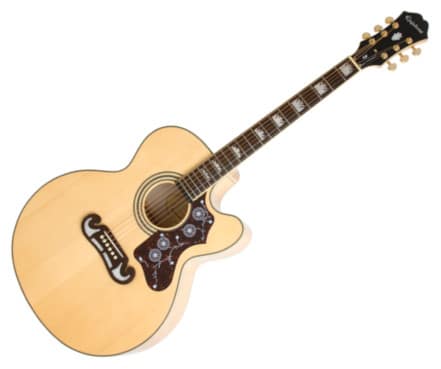
If you want a guitar that is a bit better quality, then I recommend the J-200 EC from Epiphone. Epiphone has a great way of adding a vintage look to their guitars. This is what you will find here when you look at it.
This guitar is a bit bigger, but the sound is as well. It’s comfortable and is an easy strummer with each note being amplified in a well-balanced manner. It also has electronics if you need a bit more volume to fill a room.
Classical Guitar Recommendations
Maybe the classical guitar is the one you want to go with because it matches your musical preferences. In this case, I have some great recommendations for you!
Yamaha C40II
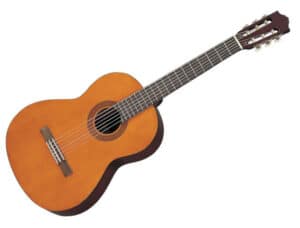
Yamaha makes some excellent guitars, even when they are aimed at beginners. This is where you will find the C40II. If you have a small budget, then this is the classical guitar for you!
The guitar doesn’t come with any add-ons or upgrades, it’s just a basic classical that is a good fit for someone just getting started. I wouldn’t recommend any other guitars, as the focus should be on the essentials.
Martin 16 Series 000C12-16E

If you are a more experienced player, or just want a higher quality guitar, then the 000C12-16E is what you want. The body is made to be a bit smaller, which is what the aim of a classical guitar was to begin with.
It has a beautiful, dynamic sound and thanks to the cut away, you have better access to the upper frets on the neck. And to make it even sweeter, you have access to built in electronics!
Conclusion
Choosing between an acoustic and a classical guitar involves careful consideration. Explore your personal preferences, musical goals, comfort levels, and budget.
By taking the time to evaluate and understand the characteristics of each instrument, you can make a better decision. One that will support your growth and enjoyment as a guitarist.
FAQ
Can I play classical music on an acoustic?
Yes, you can play classical music on a steel string acoustic. However, the tone and sound characteristics may differ from those of a classical instrument with nylon strings.
Can I use a pick on a classical guitar?
It’s possible to use a pick on a classical guitar. But traditional techniques involve fingerpicking. So try using the fingers to pluck the strings in this case.
Is it possible to switch between acoustic and classical playing styles?
Yes, many guitarists switch between acoustic and classical guitar playing styles. However, it may take some time to adapt to the different techniques, strings, and neck widths.
Should a beginner use a classical guitar?
Yes, the classical guitar is a great choice for a beginner. The nylon strings are easier on the fingers and the guitar body is quite comfortable. The only factor that you should consider is the music style.
Is it hard to string a classical guitar?
It’s important to consider that a classical guitar can be harder to string than a regular steel-string acoustic. The nylon strings don’t have any ball ends, which means they need to be tied to the bridge.

